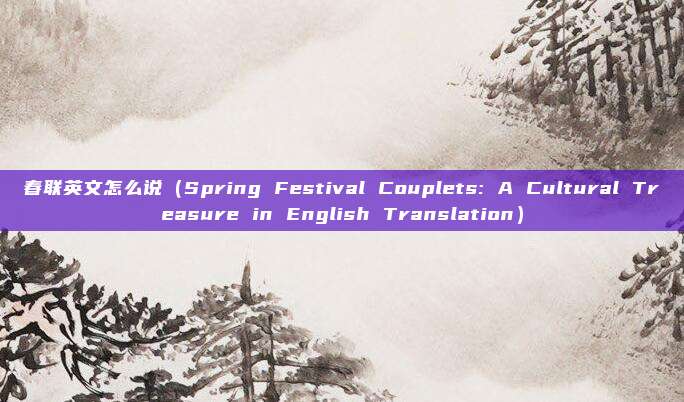春联英文怎么说(Spring Festival Couplets: A Cultural Treasure in English Translation)
温馨提示:这篇文章已超过297天没有更新,请注意相关的内容是否还可用!
The Chinese New Year, also known as the Spring Festival, is one of the most important and widely celebrated festivals in China. A significant aspect of this celebration is the traditional practice of hanging spring couplets, which are pairs of red and black calligraphy that adorn the doors of homes and businesses. These couplets are not only a beautiful decoration but also carry profound meanings and wishes for the coming year. In this article, we will explore the significance of spring couplets, their cultural background, and how they can be beautifully translated into English.
The Significance of Spring Couplets
Spring couplets are much more than mere decorations; they are a reflection of Chinese culture and tradition. They are believed to bring good fortune, happiness, and prosperity to the household. The red color symbolizes good luck and joy, while the black calligraphy represents strength and elegance. The couplets often contain auspicious phrases or poems that are meant to inspire and uplift the spirit of those who read them.
Cultural Background

The practice of hanging spring couplets dates back to the Song Dynasty (960-1279 AD). Initially, they were used to ward off evil spirits and bring good luck. Over time, they evolved into a symbol of family unity, prosperity, and happiness. The couplets are usually written by family members or friends and are considered a gift of good wishes.
Types of Spring Couplets
There are various types of spring couplets, each with its own unique meaning and style. Some are humorous, while others are poetic. Here are a few examples:
1、Poetic Spring Couplets: These couplets are written in classical Chinese poetry form and often contain metaphors and allusions. They are highly appreciated for their artistic beauty and depth of meaning.
2、Folk Spring Couplets: These couplets are more straightforward and are often based on common sayings and proverbs. They are easily understood and appreciated by people of all ages.
3、Modern Spring Couplets: With the influence of modern culture, some couplets are written in contemporary Chinese or even in English. These couplets blend traditional values with modern aesthetics.
Translating Spring Couplets into English
Translating spring couplets into English can be a challenging task, as the meanings and nuances of the original text can be lost in translation. However, with a careful approach, it is possible to convey the essence of the couplets in English while maintaining their cultural significance.
Here are some tips for translating spring couplets:
1、Understand the Context: Before translating, it's essential to understand the context and the intended message of the couplet.
2、Choose the Right Words: Use words that capture the essence of the original text and convey the same emotions and wishes.
3、Maintain the Rhythm: Try to maintain the rhythm and structure of the original couplet, as this can help preserve the poetic beauty of the text.
4、Use Cultural References: If necessary, include cultural references that are familiar to English speakers, such as Chinese idioms or symbols.
5、Seek Feedback: It's always a good idea to have someone else read your translation to ensure that it conveys the intended message and is easy to understand.
Conclusion
Spring couplets are a cherished cultural tradition that embodies the spirit of the Chinese New Year. Translating them into English allows us to share this beautiful tradition with a wider audience. While it may be challenging to capture the full essence of these couplets in English, with a careful and thoughtful approach, we can still convey their meaning and beauty, bridging the cultural gap and celebrating the universal themes of hope, happiness, and prosperity.
网站文章、图片来源于网络,以不营利的目的分享经验知识,版权归原作者所有。如有侵权请联系删除!





还没有评论,来说两句吧...